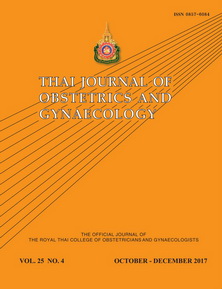The Predictive Value of Post Processing Total Motile Sperm Count of Semen on the Success of Intrauterine Insemination
Main Article Content
Abstract
Objectives: To study the predictive value of post-processing total motile sperm count (TMSC) on pregnancy rate in intrauterine insemination (IUI).
Materials and Methods: Medical records were reviewed from August 2013 to January 2015. All unexplained infertile women or anovulation less than or equal to 35 years old, and initially treated with IUI were included. Small myoma, adenomyosis, adenomyoma, endometrial thickness less than 6 mm at 2-3 days before IUI and patients with previous pelvic surgery were excluded. The predictive values of post-processing TMSC parameters were analyzed regarding pregnancy outcomes with a receiver operating characteristic (ROC) curve.
Results: The overall pregnancy rate was 9.5% for all 218 couples with 314 IUI cycles. The cause of female infertility was unexplained for 75.16% of the sample population with anovulation at 24.84%. All parameters including duration of infertility, number of dominant follicles, largest dominant follicle diameter and endometrial thickness were unrelated to pregnancy outcomes. The ROC showed sensitivity, specificity, positive predictive value and negative predictive value of post-processing TMSC at 20x106/mm, with pregnancy outcomes of 50, 45, 48, and 47%, respectively.
Conclusion: Post-processing TMSC was an unreliable predictive factor for IUI outcome.
Keywords: total motile sperm count, pregnancy outcome, intrauterine insemination.
Article Details
References
2. Cohlen BJ. Should we continue performing intrauterine inseminations in the year 2004? Gynecol Obstet Invest 2005;59:3-13.
3. Goverde AJ, McDonnell J, Vermeiden JP, Schats R, Rutten FF, Schoemaker J. Intrauterine insemination or in-vitro fertilisation in idiopathic subfertility and male subfertility: a randomised trial and cost-effectiveness analysis. Lancet 2000;355:13-8.
4. Dickey RP, Taylor SN, Lu PY, Sartor BM, Rye PH, Pyrzak R. Effect of diagnosis, age, sperm quality, and number of preovulatory follicles on the outcome of multiple cycles of clomiphene citrate-intrauterine insemination. Fertil Steril 2002;78:1088-95.
5. Merviel P, Heraud MH, Grenier N, Lourdel E, Sanguinet P, Copin H. Predictive factors for pregnancy after intrauterine insemination (IUI): an analysis of 1038 cycles and a review of the literature. Fertil Steril 2010;93:79-88.
6. Xiao CW, Agbo C, Dahan MH. Comparison of pregnancy rates in pre-treatment male infertility and low total motile sperm count at insemination. Arch Gynecol Obstet 2016;293:211-7.
7. Allen NC, Herbert CM, 3rd, Maxson WS, Rogers BJ, Diamond MP, Wentz AC. Intrauterine insemination: a critical review. Fertil Steril 1985;44:569-80.
8. Kolibianakis EM, Zikopoulos KA, Fatemi HM, Osmanagaoglu K, Evenpoel J, Van Steirteghem A, et al. Endometrial thickness cannot predict ongoing pregnancy achievement in cycles stimulated with clomiphene citrate for intrauterine insemination. Reprod Biomed Online 2004;8:115-8.
9. Tomlinson MJ, Amissah-Arthur JB, Thompson KA, Kasraie JL, Bentick B. Prognostic indicators for intrauterine insemination (IUI): statistical model for IUI success. Hum Reprod 1996;11:1892-6.
10. Ombelet W, Dhont N, Thijssen A, Bosmans E, Kruger T. Semen quality and prediction of IUI success in male subfertility: a systematic review. Reprod Biomed Online 2014;28:300-9.
11. Soria M, Pradillo G, Garcia J, Ramon P, Castillo A, Jordana C, et al. Pregnancy predictors after intrauterine insemination: analysis of 3012 cycles in 1201 couples. J Reprod Infertil 2012;13:158-66.
12. Berg U, Brucker C, Berg FD. Effect of motile sperm count after swim-up on outcome of intrauterine insemination. Fertil Steril 1997;67:747-50.
13. Huang HY, Lee CL, Lai YM, Chang MY, Wang HS, Chang SY, et al. The impact of the total motile sperm count on the success of intrauterine insemination with husband’s spermatozoa. J Assist Reprod Genet 1996;13:56-63.
14. Khalil MR, Rasmussen PE, Erb K, Laursen SB, Rex S, Westergaard LG. Homologous intrauterine insemination. An evaluation of prognostic factors based on a review of 2473 cycles. Acta Obstet Gynecol Scand 2001;80:74-81.
15. Branigan EF, Estes MA, Muller CH. Advanced semen analysis: a simple screening test to predict intrauterine insemination success. Fertil Steril 1999;71:547-51.
16. Miller DC, Hollenbeck BK, Smith GD, Randolph JF, Christman GM, Smith YR, et al. Processed total motile sperm count correlates with pregnancy outcome after intrauterine insemination. Urology 2002;60:497-501.
17. van der Westerlaken LA, Naaktgeboren N, Helmerhorst FM. Evaluation of pregnancy rates after intrauterine insemination according to indication, age, and sperm parameters. J Assist Reprod Genet 1998;15:359-64.
18. Organization WH. WHO laboratory manual for the examination of human semen and sperm-cervical mucus interaction. ed. t, editor. Cambridge: Cambridge University Press; 2010.
19. Ayala C, Steinberger E, Smith DP. The influence of semen analysis parameters on the fertility potential of infertile couples. J Androl 1996;17:718-25.
20. Luco SM, Agbo C, Behr B, Dahan MH. The evaluation of pre and post processing semen analysis parameters at the time of intrauterine insemination in couples diagnosed with male factor infertility and pregnancy rates based on stimulation agent. A retrospective cohort study. Eur J Obstet Gynecol Reprod Biol 2014;179:159-62.
21. Brasch JG, Rawlins R, Tarchala S, Radwanska E. The relationship between total motile sperm count and the success of intrauterine insemination. Fertil Steril 1994;62:150-4.
22. Tay PY, Raj VR, Kulenthran A, Sitizawiah O. Prognostic factors influencing pregnancy rate after stimulated intrauterine insemination. Med J Malaysia 2007;62:286-9.
23. Lee VM, Wong JS, Loh SK, Leong NK. Sperm motility in the semen analysis affects the outcome of superovulation intrauterine insemination in the treatment of infertile Asian couples with male factor infertility. BJOG 2002;109:115-20.
24. Kruger TF, Menkveld R, Stander FS, Lombard CJ, Van der Merwe JP, van Zyl JA, et al. Sperm morphologic features as a prognostic factor in in vitro fertilization. Fertil Steril 1986;46:1118-23.
25. Oehninger S, Acosta AA, Kruger T, Veeck LL, Flood J, Jones HW, Jr. Failure of fertilization in in vitro fertilization: the “occult” male factor. J In Vitro Fert Embryo Transf 1988;5:181-7.
26. Hauser R, Yogev L, Botchan A, Lessing JB, Paz G, Yavetz H. Intrauterine insemination in male factor subfertility: significance of sperm motility and morphology assessed by strict criteria. Andrologia 2001;33:13-7.


